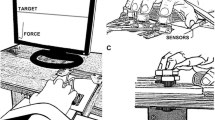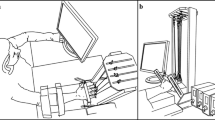Abstract
The framework of the uncontrolled manifold (UCM) hypothesis was used to explore variables related to stability of task performance in the two hands of young healthy individuals. Fourteen young adults performed four-finger accurate constant force production tasks interrupted by a voluntary quick force pulse production and by an externally imposed displacement of all fingers. Three groups of variables were used to quantify stability of steady force production: (1) indices of the inter-trial variance were computed within the UCM and orthogonal to the UCM; (2) indices of motor equivalence were computed between steady-state intervals separated by the force pulse and by the finger-lifting episode; and (3) referent coordinate and apparent stiffness were computed using the data during the ascending phase of the finger-lifting episode. In another task, the subjects performed accurate constant force production with visual feedback removal after the 8th second, and the drop in the total force after the removal was computed. There were differences between the right and left hand in some outcome variables such as variance within the UCM, and the timing of anticipatory synergy adjustments prior to the force pulse, consistent with the dynamic dominance hypothesis. There were significant correlations between the two hands for indices that were unrelated to accuracy of performance: variance within the UCM, index of motor equivalence, referent coordinate, apparent stiffness, and the drop of total force after visual feedback removal. We interpret these findings within the concept of stability–optimality trade-off. In particular, we conclude that individual subjects select particular, person-specific solutions within the spectrum allowed by the explicit task constraints, and this choice is consistent between the two hands. We conclude with a hypothesis that selecting specific solutions within the stability–optimality trade-off may represent an individual’s personal preference consistent between the two hands.





Similar content being viewed by others
References
Ambike S, Zatsiorsky VM, Latash ML (2015) Processes underlying unintentional finger force changes in the absence of visual feedback. Exp Brain Res 233:711–721
Ambike S, Mattos D, Zatsiorsky VM, Latash ML (2016a) Synergies in the space of control variables within the equilibrium-point hypothesis. Neurosci 315:150–161
Ambike S, Mattos D, Zatsiorsky VM, Latash ML (2016b) Unsteady steady-states: central causes of unintentional force drift. Exp Brain Res 234:3597–3611
Bernstein NA (1967) The co-ordination and regulation of movements. Pergamon Press, Oxford
Cesqui B, d’Avella A, Portone A, Lacquaniti F (2012) Catching a ball at the right time and place: individual factors matter. PLoS One 7(2):e31770
Cheng M, Kato M, Tseng CH (2017) Gender and autistic traits modulate implicit motor synchrony. PLoS One 12(9):e0184083
Curioni A, Minio-Paluello I, Sacheli LM, Candidi M, Aglioti SM (2017) Autistic traits affect interpersonal motor coordination by modulating strategic use of role-based behavior. Mol Autism 8:23
de Freitas PB, Freitas SMSF, Lewis MM, Huang X, Latash ML (2018) Stability of steady hand force production explored across spaces and methods of analysis. Exp Brain Res 236:1545–1562
Diedrichsen J, Shadmehr R, Ivry RB (2010) The coordination of movement: optimal feedback control and beyond. Trends Cogn Sci 14:31–39
Feldman AG (2015) Referent control of action and perception: challenging conventional theories in behavioral science. Springer, NY, p 244
Gelfand IM, Latash ML (1998) On the problem of adequate language in movement science. Mot Control 2:306–313
Haar S, Dinstein I, Shelef I, Donchin O (2017a) Effector-invariant movement encoding in the human motor system. J Neurosci 37:9054–9063
Haar S, Donchin O, Dinstein I (2017b) Individual movement variability magnitudes are explained by cortical neural variability. J Neurosci 37:9076–9085
Harris CM, Wolpert DM (1998) Signal-dependent noise determines motor planning. Nature 394:780–784
Harris JM, Best CS, Moffat VJ, Spencer MD, Philip RC, Power MJ, Johnstone EC (2008) Autistic traits and cognitive performance in young people with mild intellectual impairment. J Autism Dev Disord 38:1241–1249
Jo HJ, Park J, Lewis MM, Huang X, Latash ML (2015) Prehension synergies and hand function in early-stage Parkinson’s disease. Exp Brain Res 233:425–440
Jo HJ, Lucassen E, Huang X, Latash ML (2017) Changes in multi-digit synergies and their feed-forward adjustments in multiple sclerosis. J Mot Behav 49:218–228
Latash ML (2010) Motor synergies and the equilibrium-point hypothesis. Mot Control 14:294–322
Latash ML (2012) The bliss (not the problem) of motor abundance (not redundancy). Exp Brain Res 217:1–5
Latash ML (2016) Towards physics of neural processes and behavior. Neurosci Biobehav Rev 69:136–146
Latash ML (2017) Biological movement and laws of physics. Mot Control 21:327–344
Latash ML, Anson JG (1996) What are normal movements in atypical populations? Behav Brain Sci 19:55–106
Latash ML, Huang X (2015) Neural control of movement stability: lessons from studies of neurological patients. Neurosci 301:39–48
Latash ML, Scholz JF, Danion F, Schöner G (2002) Finger coordination during discrete and oscillatory force production tasks. Exp Brain Res 146:412–432
Lewis MM, Lee E-Y, Jo HJ, Park J, Latash ML, Huang X (2016) Synergy as a new and sensitive marker of basal ganglia dysfunction: a study of asymptomatic welders. Neurotoxicology 56:76–85
Lingam R, Golding J, Jongmans MJ, Hunt LP, Ellis M, Emond A (2010) The association between developmental coordination disorder and other developmental traits. Pediatrics 126(5):e1109–e1118
Martin JR, Budgeon MK, Zatsiorsky VM, Latash ML (2011) Stabilization of the total force in multi-finger pressing tasks studied with the ‘inverse piano’ technique. Hum Move Sci 30:446–458
Mattos D, Latash ML, Park E, Kuhl J, Scholz JP (2011) Unpredictable elbow joint perturbation during reaching results in multijoint motor equivalence. J Neurophysiol 106:1424–1436
Mattos D, Schöner G, Zatsiorsky VM, Latash ML (2015) Motor equivalence during accurate multi-finger force production. Exp Brain Res 233:487–502
Miller LE, Saygin AP (2013) Individual differences in the perception of biological motion: links to social cognition and motor imagery. Cognition 128:140–148
Müller H, Sternad D (2003) A randomization method for the calculation of covariation in multiple nonlinear relations: illustrated with the example of goal-directed movements. Biol Cybern 89:22–33
Newell KM, Carlton LG (1993) Force variability in isometric responses. J Exp Psychol Hum Percept Perform 14:37–44
Olafsdottir H, Yoshida N, Zatsiorsky VM, Latash ML (2005) Anticipatory covariation of finger forces during self-paced and reaction time force production. Neurosci Lett 381:92–96
Park J, Zatsiorsky VM, Latash ML (2010) Optimality vs. variability: an example of multi-finger redundant tasks. Exp Brain Res 207:119–132
Park J, Wu Y-H, Lewis MM, Huang X, Latash ML (2012) Changes in multi-finger interaction and coordination in Parkinson’s disease. J Neurophysiol 108:915–924
Parsa B, O’Shea DJ, Zatsiorsky VM, Latash ML (2016) On the nature of unintentional action: a study of force/moment drifts during multi-finger tasks. J Neurophysiol 116:698–708
Petrosini L, Cutuli D, Picerni E, Laricchiuta D (2015) Cerebellum and personality traits. Cerebellum 14:43–46
Picerni E, Petrosini L, Piras F, Laricchiuta D, Cutuli D, Chiapponi C, Fagioli S, Girardi P, Caltagirone C, Spalletta G (2013) New evidence for the cerebellar involvement in personality traits. Front Behav Neurosci 7:133
Prilutsky BI, Zatsiorsky VM (2002) Optimization-based models of muscle coordination. Exer Sport Sci Rev 30:32–38
Reschechtko S, Latash ML (2017) Stability of hand force production: I. Hand level control variables and multi-finger synergies. J Neurophysiol 118:3152–3164
Reschechtko S, Latash ML (2018) Stability of hand force production: II. Ascending and descending synergies. J Neurophysiol 120:1045–1060
Reschechtko S, Zatsiorsky VM, Latash ML (2017) The synergic control of multi-finger force production: stability of explicit and implicit task components. Exp Brain Res 235:1–14
Sainburg RL (2002) Evidence for a dynamic-dominance hypothesis of handedness. Exp Brain Res 142:241–258
Sainburg RL (2005) Handedness: differential specializations for control of trajectory and position. Exerc Sport Sci Rev 33:206–213
Scholz JP, Schöner G (1999) The uncontrolled manifold concept: identifying control variables for a functional task. Exp Brain Res 126:289–306
Scholz JP, Danion F, Latash ML, Schöner G (2002) Understanding finger coordination through analysis of the structure of force variability. Biol Cybern 86:29–39
Schöner G (1995) Recent developments and problems in human movement science and their conceptual implications. Ecol Psychol 8:291–314
Shim JK, Olafsdottir H, Zatsiorsky VM, Latash ML (2005) The emergence and disappearance of multi-digit synergies during force production tasks. Exp Brain Res 164:260–270
Sosnoff JJ, Newell KM (2006) The generalization of perceptual-motor intra-individual variability in young and old adults. J Gerontol B Psychol Sci Soc Sci 6:P304–P310
Todorov E (2004) Optimality principles in sensorimotor control. Nat Neurosci 7:907–915
Todorov E, Jordan MI (2002) Optimal feedback control as a theory of motor coordination. Nat Neurosci 5:1226–1235
Vaillancourt DE, Russell DM (2002) Temporal capacity of short-term visuomotor memory in continuous force production. Exp Brain Res 145:275–285
Wang J, Sainburg RL (2007) The dominant and nondominant arms are specialized for stabilizing different features of task performance. Exp Brain Res 178:565–570
Zaback M, Cleworth TW, Carpenter MG, Adkin AL (2015) Personality traits and individual differences predict threat-induced changes in postural control. Hum Mov Sci 40:393–409
Zhang W, Sainburg RL, Zatsiorsky VM, Latash ML (2006) Hand dominance and multi-finger synergies. Neurosci Lett 409:200–204
Acknowledgements
The study was in part supported by NIH Grants NS082151 and NS095873.
Author information
Authors and Affiliations
Corresponding author
Rights and permissions
About this article
Cite this article
de Freitas, P.B., Freitas, S.M.S.F., Lewis, M.M. et al. Individual preferences in motor coordination seen across the two hands: relations to movement stability and optimality. Exp Brain Res 237, 1–13 (2019). https://doi.org/10.1007/s00221-018-5393-1
Received:
Accepted:
Published:
Issue Date:
DOI: https://doi.org/10.1007/s00221-018-5393-1




